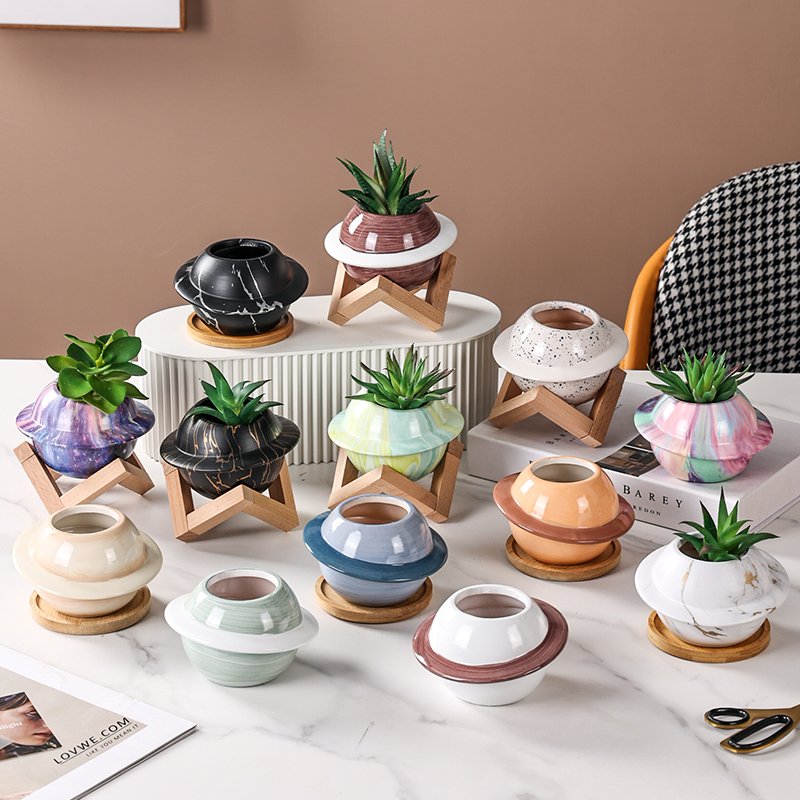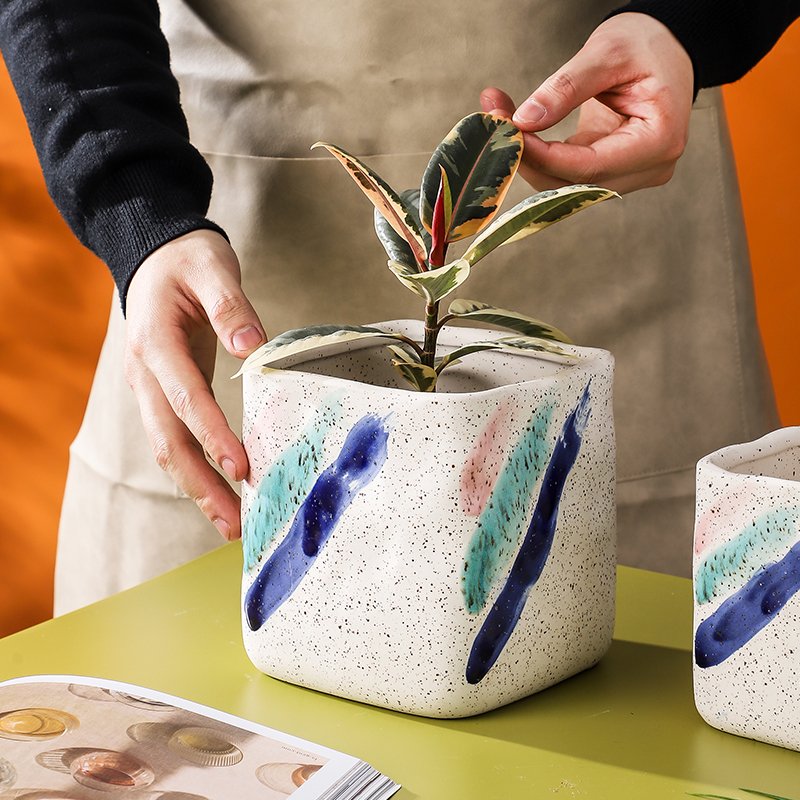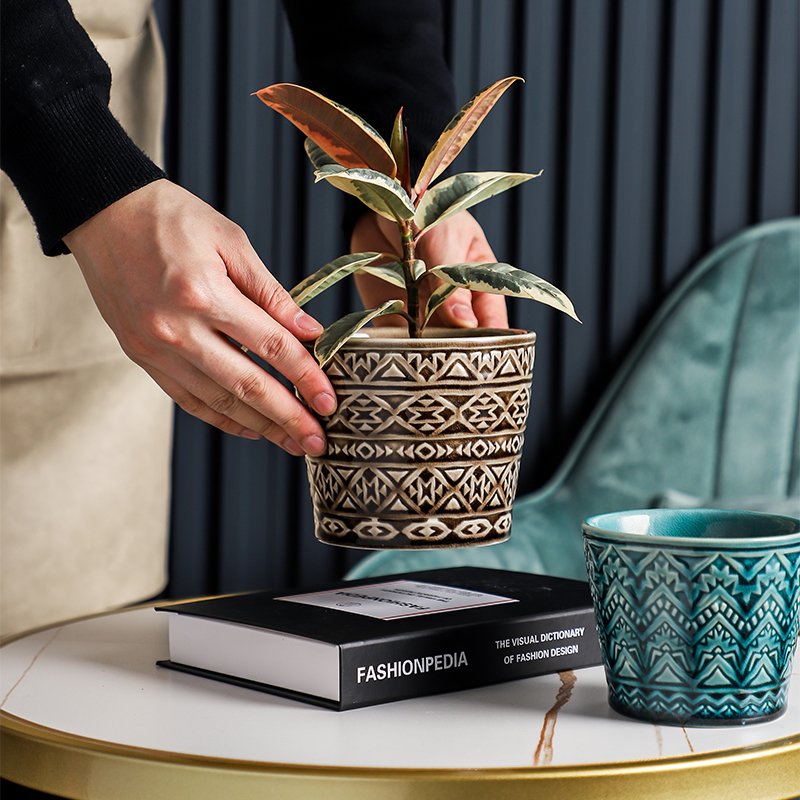Introduction
Planters come in various materials, each offering unique benefits and characteristics. Understanding the different raw materials can help you make informed decisions about which type is best suited for your needs, whether for gardening or home decor. In this comprehensive guide, we will explore three primary materials used for planters: terracotta, ceramic, and porcelain. By the end of this guide, you will have a clear understanding of each material’s properties, advantages, and ideal use cases.
Topic 1: What is Terracotta?
Definition and Origin
Terracotta, derived from the Italian words “terra” (earth) and “cotta” (cooked), refers to a type of earthenware made from natural clay. This material has been used for centuries in various cultures for making pottery, sculptures, and building materials. Its distinctive reddish-brown color comes from the iron content in the clay, which reacts with oxygen during the firing process.
Properties of Terracotta
Porosity: Terracotta is porous, allowing air and water to pass through the walls of the planter. This promotes healthy root growth and prevents waterlogging.
Breathability: The porous nature of terracotta also helps regulate soil temperature and moisture levels, creating an optimal environment for plants.
Weight: Terracotta planters are relatively heavy, providing stability for larger plants and preventing them from tipping over.

Advantages of Terracotta
Natural Aesthetic: The earthy, rustic look of terracotta complements a wide range of garden and home decor styles.
Plant Health: The breathability and porosity of terracotta planters support healthy root development and reduce the risk of root rot.
Durability: Terracotta is robust and can last for many years with proper care.
Drawbacks of Terracotta
Fragility: Terracotta can be prone to cracking or breaking if dropped or exposed to freezing temperatures.
Water Absorption: The porous nature can lead to faster evaporation of water from the soil, requiring more frequent watering.
Ideal Use Cases for Terracotta
Outdoor Gardens: Terracotta planters are perfect for outdoor settings, adding a natural touch to garden landscapes.
Mediterranean and Southwestern Decor: The warm, earthy tones of terracotta complement these decor styles beautifully.
Herbs and Succulents: Plants that prefer well-drained soil thrive in terracotta planters.
Topic 2: What is Ceramic?
Definition and Origin
Ceramic planters are made from clay that has been shaped, glazed, and fired at high temperatures. The term “ceramic” encompasses a wide range of pottery, including earthenware, stoneware, and porcelain. Glazing adds a layer of protection and aesthetic appeal, resulting in a smooth, often glossy finish.

Properties of Ceramic
Density: Ceramic planters are denser than terracotta, providing excellent durability and strength.
Non-Porosity: The glazing process makes ceramic planters non-porous, preventing water from seeping through the walls.
Weight: Ceramic planters are generally heavier than plastic but lighter than terracotta.
Advantages of Ceramic
Aesthetic Variety: Ceramic planters come in a wide range of colors, patterns, and finishes, allowing for greater design flexibility.
Durability: The firing and glazing process makes ceramic planters highly durable and resistant to weathering.
Moisture Retention: The non-porous nature helps retain soil moisture, reducing the frequency of watering.
Drawbacks of Ceramic
Cost: High-quality ceramic planters can be more expensive than other materials.
Weight: While lighter than terracotta, ceramic planters can still be heavy, making them less suitable for large-scale gardening projects.
Ideal Use Cases for Ceramic
Indoor Decor: The variety of colors and finishes makes ceramic planters ideal for indoor settings, adding a touch of elegance to home interiors.
Ornamental Plants: Decorative plants and flowers benefit from the moisture retention and aesthetic appeal of ceramic planters.
Patios and Balconies: Ceramic planters are suitable for outdoor use in controlled environments, such as patios and balconies.
Topic 3: What is Porcelain?
Definition and Origin
Porcelain is a type of ceramic made from a refined clay, typically kaolin, that is fired at very high temperatures. This process results in a hard, dense, and translucent material known for its delicate appearance and strength. Porcelain has been prized for centuries, particularly in China, for its beauty and durability.

Properties of Porcelain
Hardness: Porcelain is exceptionally hard and resistant to scratching and chipping.
Density: The high firing temperature creates a very dense material, making porcelain planters non-porous and impermeable to water.
Translucency: Porcelain’s fine grain and high density can create a translucent effect, adding a unique aesthetic quality.
Advantages of Porcelain
Aesthetic Elegance: Porcelain planters offer a sophisticated, elegant look, often with intricate designs and a smooth finish.
Durability: Despite its delicate appearance, porcelain is extremely durable and long-lasting.
Water Retention: Like other glazed ceramics, porcelain planters retain moisture well, reducing the need for frequent watering.
Drawbacks of Porcelain
Cost: Porcelain is one of the more expensive materials for planters due to its refinement and production process.
Fragility: Although durable, porcelain can be more susceptible to cracking under impact or extreme temperature changes.
Ideal Use Cases for Porcelain
High-End Interior Decor: Porcelain planters add a touch of luxury to high-end interior spaces.
Orchid Pots: The moisture retention and elegant appearance make porcelain ideal for delicate plants like orchids.
Collector’s Items: Porcelain planters are often used as decorative pieces or collector’s items due to their beauty and craftsmanship.
Conclusion
Choosing the right material for your planters involves considering the specific needs of your plants, your aesthetic preferences, and the environment where the planters will be used. Terracotta, ceramic, and porcelain each offer unique benefits and characteristics that can enhance your gardening and decor experience. By understanding these materials, you can make informed decisions that best suit your requirements and preferences.
Additional Resources
Gardening Tips: Links to articles on plant care and maintenance.
DIY Projects: Guides for customizing and decorating your planters.
Supplier Directory: List of reputable suppliers for terracotta, ceramic, and porcelain planters.
FAQs
Q: Can terracotta planters be used indoors?
A: Yes, but they require more frequent watering due to their porous nature.
Q: How do I clean ceramic planters?
A: Use mild soap and water, avoiding harsh chemicals that can damage the glaze.
Q: Are porcelain planters suitable for outdoor use?
A: Porcelain can be used outdoors, but it’s best to avoid extreme temperature changes to prevent cracking.
Appendix
Glossary
Terracotta: A type of earthenware made from natural clay, known for its reddish-brown color.
Ceramic: A broad category of pottery made from clay and fired at high temperatures, including glazed and unglazed options.
Porcelain: A refined, high-density ceramic made from kaolin clay, known for its strength and translucent quality.

